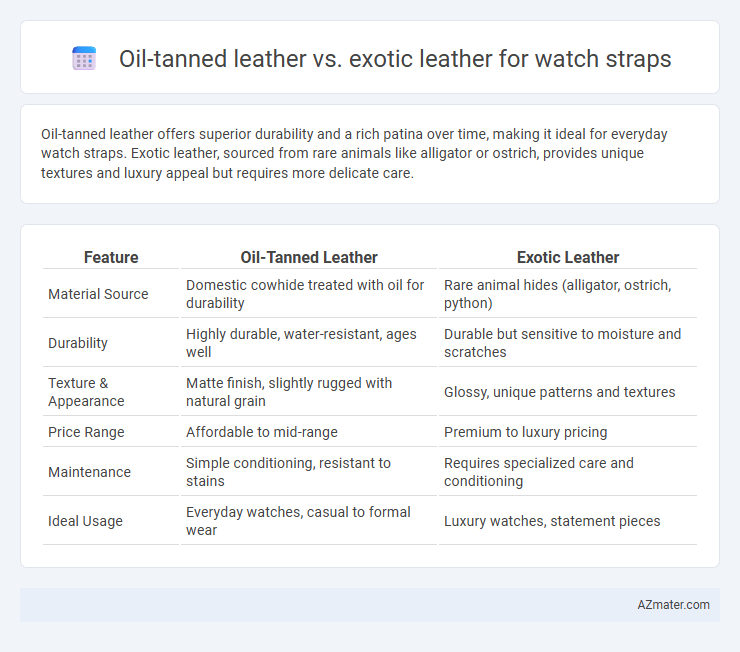Oil-tanned leather offers superior durability and a rich patina over time, making it ideal for everyday watch straps. Exotic leather, sourced from rare animals like alligator or ostrich, provides unique textures and luxury appeal but requires more delicate care.
Table of Comparison
| Feature | Oil-Tanned Leather | Exotic Leather |
|---|---|---|
| Material Source | Domestic cowhide treated with oil for durability | Rare animal hides (alligator, ostrich, python) |
| Durability | Highly durable, water-resistant, ages well | Durable but sensitive to moisture and scratches |
| Texture & Appearance | Matte finish, slightly rugged with natural grain | Glossy, unique patterns and textures |
| Price Range | Affordable to mid-range | Premium to luxury pricing |
| Maintenance | Simple conditioning, resistant to stains | Requires specialized care and conditioning |
| Ideal Usage | Everyday watches, casual to formal wear | Luxury watches, statement pieces |
Introduction to Watch Strap Materials
Oil-tanned leather offers durability and a rich patina that evolves with wear, making it a popular choice for watch straps requiring long-lasting comfort and resilience. Exotic leathers such as alligator, ostrich, and python provide unique textures and luxury appeal, often favored for high-end timepieces seeking distinctive style and exclusivity. Both materials differ significantly in maintenance needs and price points, catering to diverse preferences in watch strap aesthetics and functionality.
What is Oil-Tanned Leather?
Oil-tanned leather is a type of leather treated with natural oils during the tanning process to enhance its durability, water resistance, and suppleness, making it ideal for watch straps exposed to daily wear and moisture. Unlike exotic leathers, which are sourced from unique animals such as alligators or ostriches, oil-tanned leather offers a rugged yet soft texture that develops a rich patina over time. This combination of strength and aesthetic aging makes oil-tanned leather a popular choice for those seeking long-lasting, stylish, and functional watch straps.
What is Exotic Leather?
Exotic leather for watch straps refers to materials sourced from rare animal hides such as alligator, crocodile, ostrich, or python, known for their unique textures and high durability. Oil-tanned leather, by contrast, undergoes a specific tanning process that retains natural oils, making it supple and water-resistant but distinct in appearance and feel from exotic hides. Choosing exotic leather enhances luxury and exclusivity, while oil-tanned leather offers ruggedness and a vintage aesthetic suited for daily wear.
Appearance and Aesthetic Differences
Oil-tanned leather features a rich, matte finish with a slightly rugged texture that develops a unique patina over time, enhancing its vintage and masculine appearance. Exotic leathers, such as alligator, ostrich, or lizard, offer distinct scale patterns and natural textures, providing a luxurious and sophisticated aesthetic often favored for high-end watch straps. The choice between oil-tanned and exotic leather ultimately reflects a preference for either a rustic, durable look or an elegant, statement-making design.
Durability and Longevity Comparison
Oil-tanned leather offers exceptional durability with a robust, water-resistant surface that ages gracefully, making it ideal for daily wear watch straps. Exotic leathers, such as alligator or ostrich, provide unique textures and high durability but often require more delicate care to maintain longevity. Both materials ensure long-lasting use, though oil-tanned leather generally withstands rough conditions better while exotic leather maintains its distinct appearance with proper maintenance.
Comfort and Wearability
Oil-tanned leather offers exceptional softness and pliability, conforming comfortably to the wrist over time while maintaining durability and resistance to water and stains. Exotic leathers, such as alligator or ostrich, provide a unique textured appearance and a firmer feel, which may require a break-in period but excel in long-lasting wearability with proper care. For everyday comfort, oil-tanned leather stands out due to its natural breathability and flexibility, whereas exotic leather is favored more for luxury appeal and distinctive aesthetics.
Maintenance and Care Requirements
Oil-tanned leather watch straps require regular conditioning with leather oils to maintain flexibility and prevent cracking, while avoiding prolonged exposure to water which can cause staining. Exotic leather straps, such as alligator or ostrich, demand specialized creams and careful handling to preserve their unique textures and avoid damage from moisture or harsh chemicals. Both types benefit from gentle cleaning with a soft cloth and storing in a cool, dry place to extend strap longevity.
Price and Availability
Oil-tanned leather watch straps offer a balance of durability and affordability, typically priced lower and widely available from numerous suppliers. Exotic leather straps, such as alligator or ostrich, command a premium price due to their rarity and intricate craftsmanship, resulting in limited availability and higher exclusivity. Consumers seeking luxury and uniqueness often opt for exotic leathers, while budget-conscious buyers prefer the accessible pricing and consistent supply of oil-tanned leather.
Ethical and Environmental Considerations
Oil-tanned leather offers a more sustainable option for watch straps due to its use of natural oils and traditional tanning methods that reduce chemical waste and water pollution. Exotic leathers, sourced from rare or protected species, often raise ethical concerns surrounding animal welfare and biodiversity loss, with production processes typically involving higher environmental footprints. Choosing oil-tanned leather aligns better with eco-conscious consumer preferences prioritizing ethical sourcing and lower environmental impact.
Choosing the Right Leather for Your Watch Strap
Oil-tanned leather offers exceptional durability and a rich, rugged patina that enhances with wear, making it ideal for everyday watch straps requiring both toughness and comfort. Exotic leathers, such as alligator or ostrich, provide a distinct texture and luxury appeal, perfect for formal or statement timepieces, but may demand more care due to their delicate nature. Selecting the right leather for your watch strap depends on lifestyle, maintenance preferences, and the desired balance between durability and aesthetic sophistication.

Infographic: Oil-tanned leather vs Exotic leather for Watch strap
 azmater.com
azmater.com